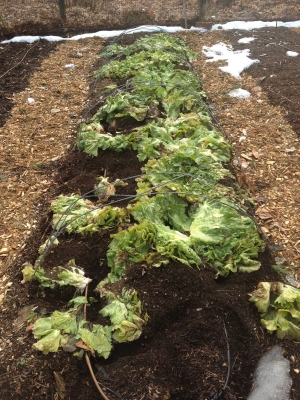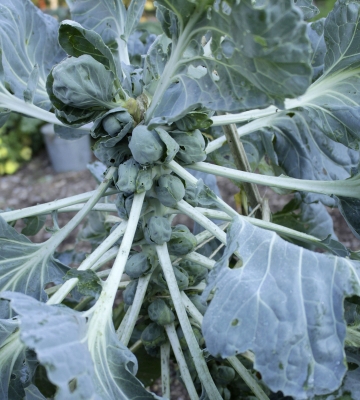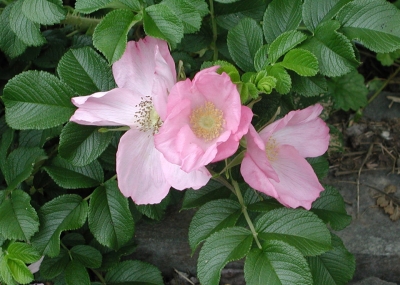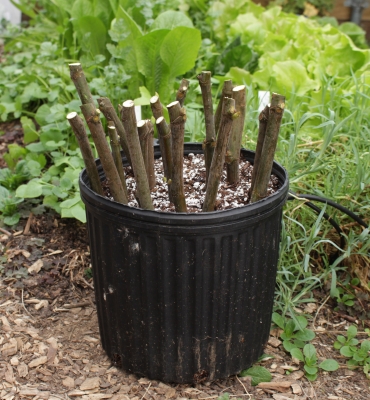NOTES TO MESELF
/9 Comments/in Fruit, Gardening, Pests, Planning/by Lee ReichOf Mice, Disease, To Grow, and Not To Grow
Despite rain, some snow, and temperatures that dipped below 10°F, the whole bed of endive was lush and green. A low tunnel of porous, light fabric and clear plastic held aloft by wire hoops kept the worst of the weather at bay. As I reached in to harvest a head, no knife was necessary; the head lifted, unattached, off the ground. Mice have been at work again!
If it’s not one thing, it’s another. A timely sowing of endive seeds (early July) gave sturdy seedlings that were transplanted (early August) into compost enriched soil to present (by September) a beautiful bed of wall to wall greenery. The beds were covered for cold protection in November.
What a cozy home that bed became for mice. The tunnel provided not only food and lodging but also cover from the hungry eyes of local hawks. The mice ignored endive’s leaves, instead devouring the stout, fleshy portions of root and stem at the base of almost every plant.
Note to myself: Next fall pre-empt mice by getting a supplemental cat or two and/or setting traps within wooden boxes having mouse-sized entry doors.
Rip Out the Clem’s, Plant New Ones
Another note to myself: Replant clematis.
Over the years I’ve accumulated a number of varieties of clematis. The vines barrel up and over fences and trellises clothing them in sumptuous blooms. Blossoming has diminished over the years, the culprit being clematis wilt, a fungal disease that turns leaves and stems black. It doesn’t usually kill the plant but a clematis without flowers and with blackened leaves and stems is not a pretty site.
Clematis and I are not finished. In the next few weeks I must sit down and seek out sources for native clematis species and their hybrids. Their flowers are smaller but they are resistant to wilt. Scarlet Clematis (Clematis texensis) is definitely on my list, as is Rock Clematis (C. columbiana, sometimes listed as C. occidentalis var. columbiana), and the hybrids Betty Corning and Étoile Violette. The choices don’t stop there because two breeders on the other side of the Atlantic have come up with a whole series of wilt-resistant clematis, known as Evison-Poulsen series.
To Grow or Not To Grow, That is the Question(s)
More notes to myself on plants to grow and not to grow next year.
My zinnias looked a little unusual this year, unusually pretty, each flower with a single row of yellow petals radiating from a brown eye. Also unusual in being very compact, long lasting, and not marred by the powdery mildew of most zinnias. Last year I had just a few of these hybrid Zahara Yellow Improved zinnias in the vegetable garden; next year I’m planning for enough to make a bold, yellow line along each edge of the main path.
It was a great year for peppers, and the greatest, for flavor and production, were Carmen, Sweet Italia, and Pepperocini. Great for production but not so great for flavor was King of the North, which won’t be invited back. In its place, I’ll be inviting Bridge to Paris pepper, recommended by a knowledgable friend.
Cardoon, the variety Hunchback of Nice, was better than expected but not good enough to justify the growing again of last season’s 10 plants. Each plant is bold and striking with upright, to 3 feet or more, blue-green leaves, so my plan is to grow only 2 or 3 as ornamentals from which I’ll steal occasional leaves for eating.
Meserve holly bushes that I planted many years ago have grown large to create a solid wall of lustrous, spiny leaves. That’s nice. Even nicer would be red berries against that verdant backdrop. Close inspection of the flowers last spring indicated that all the plants, contrary to what was ordered, are females. One male, which I will order, can sire them all so that in a few (very few, I hope) years, red berries will liven up the scene in winter.
I completely forgot to plant ginger this year. Yes, ginger, that tropical plant which has captured the interest of many small farmers. I could never understand the big deal about ginger until I experienced the tenderness of freshly harvested, red blushed baby ginger. Not that mature ginger could anyway be harvested in the short growing season this far north. My plan is to buy a ginger root in March, divide it up and pot up each section, then keep the pots warm and moist to give the roots an early start for a good harvest of baby ginger.
Brussels Sprouts, the variety Gusto, were a rousing success, perhaps too rousing because we still have 6 stalks perched in a bucket in the cool mud room and awaiting dinners. Four to six plants will be plenty for next year.
Not every vegetable needs to be loved by everyone. Next year, and in years hence until I forget what they taste like, I will not be growing broccoli or beets.
NICE HIPS, BUT WHOSE?
/4 Comments/in Flowers, Fruit, Gardening/by Lee Reich2 Contenders for Hips and Rabbi Samuel Redux
As I walked along the beach, I took a look and my first thought was “Nice hips.” But what about the flowers? I’d have to return to the plant next summer to find out, a problem since I was 4 hours from home visiting a relative in Rhode Island.
Most of the roses you see growing seaside are Rosa rugosa. Common names for this plant are Japanese rose, indicating its origin, saltspray rose, indicating its tolerance to beach sand, and rugose rose. “Rugose” means “wrinkled,” which is what leaves of R. rugosa are.
The particular planting of nice-hipped roses staring back at me did not have rugose leaves. What’s more, the hips were about 3/4 of an inch across and bright red. Hips of rugose rose are usually an inch or more across and orangish-red. With this slightly different morphology and the fact that rugose rose is listed as an invasive plant, I assumed that the nice-hipped roses, recently installed as landscape plants, were another species.
With such nice hips, the plants could possibly be dog rose, R. canina, the other rose species valued for its hips. The lack of sepals on the hips also pointed the finger at dog rose. (Rugose rose hips have persistent sepals.) A even closer look would have nailed it; rugose rose’s stems have numerous prickles throughout their length while bold, large, wide, downward-facing thorns line dog rose stems. But I didn’t look closer.
Dog rose, although much less frequently seen, is also considered invasive in some places.
Sowing Seeds for More Hips (and Flowers)
As potentially invasive plants, rugose rose or dog rose should be easy to grow from seed. But no. I’ve propagated roses from seed, and it’s a slow process.
Rose seeds, like those of most other fall-ripening seeds of temperate zone plants, have a physiological dormancy that prevents their immediate sprouting, the consequence of which would be death from cold. So they just sit in moist earth until they have experienced a number of hours of chilly temperatures — 30 to 45° F is ideal — before sprouting, at which time winter has presumably given way to spring weather. Instead of moist earth, that chilly habitat could be within the refrigerator in a plastic bag filled with peat moss and perlite.
But rose seeds have another impediment to germination: a tough seed coat. Plant the seed outdoors and shoots might not poke through the surface of the ground for 2 years. The first winter and summer are spent softening the seed coat, making it permeable to moisture. Beginning the second fall, chilling hours begin to accumulate so that by the second spring, the seed can awaken and grow.
I did pluck a few fruits from that Rhode Island, nice-hipped rose bush, and plan to make new bushes. But I’m too impatient to wait 2 years. “Scarifying” the seeds is a quick way to make the seed coats more permeable. Nicking them with a wire cutter does the trick but would be difficult with such small seeds. An hour or so in warm, concentrated sulfuric acid — followed by a thorough rinsing in water — is likewise effective but a bit dangerous. I’ll follow Mother Nature’s lead and soften the seed coats by keeping the seeds warm and moist. No matter how the seed coat is softened, subsequent cool, moist conditions are still needed before the seeds will sprout.
There’s barely time to get those seeds growing this spring. Two months in moist warmth followed by 2 to 3 months in moist peat and perlite in the refrigerator should awaken them. It’s exciting to check the bag in the refrigerator because, once mechanical and chemical barriers to germination have been overcome, a bag of seeds is usually transformed to a bag of white root sprouts, all at once, as if a switch had been turned on.
The Rabbi Multiplies
I’ll have to make up some extra peat-perlite mix. Cutting all the vertical shoots of Rabbi Samuel fig espalier back to the horizontal arms of the permanent “T” framework have yielded a pile of long stems. I can’t bear to throw them away because every foot-long section has the potential to make a whole new plant.
The rooting media for these hardwood cuttings? Peat and perlite again. A bunch of the stems in a deep pot with just their top buds up out of the peat mix should sprout and root by spring.
Not sure what I’ll do with all the resulting fig plants.
So Many Roses, I Hope
I’m also not sure what I’ll do with all the anticipated rose seedlings, especially since I’m not even sure of their species. I did telephone the public works department of the Rhode Island town where the roses were planted and was told that they were Rosa rugosa. I think they are wrong.
No matter: Rosa rugosa is one of the most fragrant roses with deep pink, sometimes white, flowers that are borne all summer long. Also, like dog rose, with nice, fleshy hips, good enough fresh and excellent for jam and tea.
STILL SOME FRESH FRUIT, and GENDER STEREOTYPING
/3 Comments/in Flowers, Fruit, Gardening, Houseplants, Planning/by Lee ReichFruit for My Mouth, Flowers for My Eyes
As I write this, on December 1st, the Rabbi — that’s the Rabbi Samuel fig — is still ripening fruit in my barely heated greenhouse. That’s commendable. Not so commendable, however, is the flavor; cooler temperatures and sparse sunlight have taken their toll. The drooping fruits look ripe and ready to eat, inside and out, but they are no longer worth eating.
On the other hand, another fruit, Szukis American persimmons, hardly look edible but still have rich, sweet flavor. Outdoors, fruits of this variety of American persimmon cling to bare branches. Their orange skins once stretched almost to the point of breaking over the soft flesh within. Now, alternate freezing and thawing temperatures and drier air have sucked moisture and temper from the flesh, so the skins have shriveled and barely cling. Their darkening does nothing to increase the fruits’ visual appeal.
The ripe fruits are hard to distinguish, by eye, from the almost ripe fruits. The latter still retain some mouth-puckering astringency which has given American persimmons a bad name. An unripe persimmon “will draw a man’s mouth awrie with much torment” wrote Captain John Smith 400 years ago. I give Szukis’ branches a slight shake and only ripe fruits come raining to the ground, at which point the Captain’s further words ring true: “When [persimmon] is ripe, it is as delicious as an apricot.”
Can’t Help Wanting African Violets
Man can’t live by bread alone; a feast for the eyes is also in order. Well, maybe not a feast, but an appetizer, some winter flowers. Probably the easiest and most longlasting of winter blossoms are those of African violet. Okay, okay, I know that African violets have been mostly associated with doilies, lace curtains, and other appurtenances of old ladies (nothing against old ladies).
Generally, I don’t even like the color violet. But African violet’s flowers do brighten up a windowsill that looks out upon a gray and brown landscape.
Now that I’ve gotten my secret attraction to African violets off my chest, let’s talk horticulture. African violet’s whorl of leaves, like those of many low-growing perennial flowers, is actually a compressed stem, one that has been telescoped down so that each leaf and associated node originates just a fraction of an inch above the next lower leaf. But there is some distance between those nodes, so over time the stem does slowly elongate, rising higher and higher out of the ground. And side branches occasionally sprout forth from the leaf axils. The result of all this is that the potted plant becomes, over time, so overgrown with layer upon layer of leaves that the plant no longer can gather enough energy to flower well.
The solution to this problem is to make new plants and then chuck the old ones. All that’s needed to make a new plant is a leaf from an old plant and patience. So a few weeks ago I plucked a few leaves (a few, for insurance) from my old, overgrown African violet and plunged their stalks into a moist mix of peat moss and perlite. A plastic bag covering and held above the leaf cuttings by some twigs provided the needed humidity until roots could develop to keep the leaves turgid. Bright but indirect sunlight fueled, via photosynthesis, new root growth, and within a few weeks, resistance to a gentle tug on the leaves told me that roots had developed.
I removed the cover and now little plants are poking up through the ground alongside the leaf stalks. I’m going to transplant my rooted cuttings into larger pots and should, in a few weeks, be enjoying flowers. By then, I’ll have my knitting also ready.
11th Hour Apple Tree Planting
On to less gender stereotyped gardening: tree planting. Picture the day before Thanksgiving, November 26th. A wet snow is falling and beginning to whiten the ground. In my garage are two sturdy, bare root apple trees, a Hudson’s Golden Gem and an Ashmead’s Kernel, recently arrived from Cummins Nursery and needing planting.
Fortunately, I prepared the plantings site a couple of weeks previously with a 4-inch-deep, broad circle of leaf compost, the most immediate purpose of which was to keep the ground from freezing. Rushing to beat out the snow, I pulled enough compost aside to make space to dig holes, spread tree roots out in each hole, backfilled the soil, sifting it around the roots by pressing with my fingers and bouncing the tree up and down, and then settled all into place with a couple of gallons of water per plant.
I like autumn for tree planting. Roots have opportunity to grow in still warm soil (especially if mulched) while stems won’t grow and need water until spring. The soil is crumbly and soft, in good condition for digging and planting. And autumn planting leaves one less thing to do in the flurry of spring gardening.
However, winter temperatures and furry creatures can be a hazard to autumn-planted trees. The first line of defense, to fend off mice and rabbits and moderate temperatures on the trunk, is a spiral plastic tree guard. An 18” high cylinder of 1/2” hardware cloth provides further defense against mice and rabbits. Beyond that, a higher and wider cylinder of 2×4 fencing should fend off deer and my puppy Sammy. (Past puppies considered newly planted trees as playthings, fun to tug out of the ground.) And finally, the well-furnished, new tree goes into winter with some perfume, a deer-repellant spray, any of which is effective if applied before the plant gets nibbled and renewed monthly.
I expect to harvest the first apples from the new apple trees expected in 3 years.











